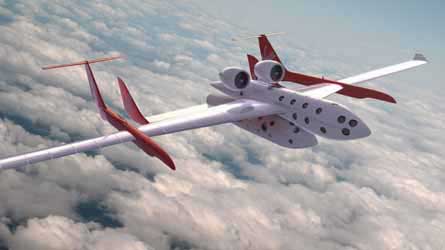Space tourism vehicle could fly 50 times in first year
Virgin Galactic's SpaceShipTwo (SS2) suborbital rocket glider may begin commercial operations in 2009, says the space tourism provider's chief pilot Stephen Johnson. The Scaled Composites-designed vehicle will have inclined pilot seats, but no fly-by-wire, he says in an exclusive first interview with Flight International.
Johnson says the world's first commercial suborbital human spaceflight vehicle will probably start operations later than planned, because of a challenging flight-test programme, but then aim for 50 or more flights in the first year.
|
|---|
Rocket glider will start late after challenging flight-test programme |
The SS2's two pilots will have inclined seats so that re-entry g forces are felt from the front of the chest to the back of the body. This will avoid the g-induced flow of blood away from the head that is encountered in fast jets.
Because pilots will experience 4g on ascent and up to 7g on descent on a daily basis, Virgin Galactic is to adopt a Lockheed Martin F-16-type training regime for flightcrew. While the retirement age for commercial pilots is 60 in the USA, and 65 internationally, Johnson expects SS2 pilots, who might not need a military background, to be younger. "I'm 48 so I am probably at the upper end of the age range," says Johnson, also a Virgin Atlantic Airways pilot. As a UK Royal Air Force Red Arrows display team pilot, Johnson pulled +6g to -3g in manoeuvres, but he expects the g to come on slower with SS2, but to remain for a "reasonable time".
Johnson is working on operational procedures with Virgin Galactic's chief test pilot David Mackay and chief training pilot Al Hoy, another former Red Arrow. Both have been using the SS1 simulator, but only former test pilot Mackay is likely to fly SS2 during development, along with Scaled's SS1 test pilot Brian Binnie.
Once operational, Johnson, Mackay, Hoy, Binnie and Virgin Galactic chief operating officer Alex Tai will fly the SS2 and its WhiteKnight 2 (WK2) carrier aircraft. Operationally, each flight will need six pilots, two in the SS2, two in the WK2 and two in mission control. A sixth pilot has to be recruited and, once commercial flight rates increase, Johnson expects the two-pilot set-up for the WK2 and SS2 to enable on-the-job training after simulator work.
- The Esrange Space Centre in northern Sweden is considering air launching sounding rockets from Virgin Galactic's WK2 carrier aircraft within the next decade. Launched at 49,200ft (15,000m), the rocket would reach a far higher altitude than today's ground launches, giving scientists a longer microgravity duration for experiments. "We are discussing the advantages and disadvantages. It is at a very early stage," said Esrange chief Olle Norberg, speaking at the signing of an agreement between Swedish Space and Virgin Galactic for Spaceport Sweden. Spaceport Sweden will be based at Kiruna airport and be the second used by Virgin Galactic after Spaceport America in New Mexico.
Source: Flight International
























